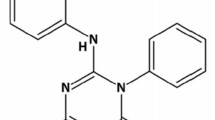Summary
Plasma levels of sparteine were determined in two groups of 8 patients each of whom received 200 mg of sparteine sulphate (Depasan®) intravenously and orally. A method was developed for the determination of sparteine in biological fluids, relying on solvent extraction and gas chromatography. After oral administration, 69.4% of the sparteine was absorbed and peak plasma levels were reached after 46.5 min. After intravenous injection the plasma levels declined with a half life of 117 min. When sparteine is given intravenously, 34.2% of the dose administered is excreted in the urine in the next 24 h as unchanged sparteine. Two metabolites were found in the urine but have not yet been identified. They contribute only a few percent to the total urinary excretion of sparteine. Approximately 50% of sparteine is bound to plasma proteins. — The pharmacokinetics of sparteine after intravenous administration can be described in terms of a one-compartment model. —The tissue distribution of sparteine was studied in preliminary experiments in rats. The drug was accumulated in several tissues, with the greatest concentration in the lungs. The hypothesis is advanced that drugs, which are organic bases with high pKa-values and high lipid solubility, are concentrated mainly in the lungs, followed by the adrenals, spleen, and the heart.
Similar content being viewed by others
Literature
Avenhaus, H., Grohmann, H.: Die Refraktärzeit des menschlichen Herzens unter Sparteinsulfat. Untersuchungen mit elektrischer Stimulation. Z. Kreisl.Forsch. 58, 54–60 (1969).
Böhme, H.: Die Behandlung von Herzrhythmusstörungen mit Sparteinsulfat. Z. Ges. inn. Med. 19, 883–889 (1964).
Boyadjian, N.: Techniques de fibrillation auriculaire expérimentale. Leur application à l'étude de quelques nouveaux antifibrillants cardiaques. Ann. Sec. roy. Sci. méd. nat. Brux. 20, 29–62 (1967).
Brochmann-Hanssen, E.: Gas chromatography of alkaloids, alkaloidal salts and derivatives. J. Pharm. Sci. 51, 1095–1098 (1962).
Caldeyro-Barcia, R., Alvarez, H.: J. Obstet. Gynaec. Brit, Emp. 59, 652 (1952).
Dengler, H. J. Eichelbaum, M.: Untersuchungen zum Verhalten von C14-D, L-Prenylamin im Organismus. Naunyn-Schmiedebergs Arch. f. Pharmakol. 260, 105 (1968).
Dost, F. H.: Kann man dem Clearance-Begriff einen solchen der „Entrance” gegeniiberstellen. Naunyn-Schmiedebergs Arch. exp. Path. Pharmak. 213, 435–452 (1951).
— Medgyesi, G.: Z. Naturforsch. 19b, 174 (1964), In: Dost, Grundlagen der Pharmakokinetik. Stuttgart: Thieme 1968.
Eichelbaum, M., Hengstmann, H. J., Dengler, H. J. Das Verteilungsmuster des Chlorphentermnis bei Ratte, Kaninchen und Schwein. In press.
Filler, W.F., Jr., Filler, N., Zinberg, S.: Sparteine sulfate in labor. Amer. J. Obstet. Gynaec. 88, 737–746 (1964).
Förster, W., Hoefke, W.: Naunyn-Schmiedebergs Arch. exp. Path. Pharmak. 239, 383–392 (1960).
Graubner, W., Kraus, H.: Über die Verstärkung der Blutdruckwirkung der Adrenalinkörper durch Spartein. Naunyu-Schmiedebergs Arch. exp. Path. Pharmak. 184, 235–240 (1937).
Heeg, E., Reuter, N., Steiger, H.: Der Einfluß antiarrhythmisch wirksamer Substanzen auf Refraktär-zeit und Kontraktionskraft von Meerschweinchenvorhöfen. Naunyn-Schmiedebergs Arch. f. Pharmak. 264, 244–245 (1969).
Lloyd, H. A.: Separation of alkaloids by gas chromatography. J. Amer. chem. Sec. 82, 37–91 (1960).
Lodi, F., Marozzi, E.: Application of gas chromatography in forensic toxicology. Farmaco 20, 9 (1965).
Krieglstein, J., Kuschinsky, G.: Quantitative Bestimmung der Eiweißbindung von Pharmaka durch Gelfiltration. Arzneimittel-Forsch. 18, 287–289 (1968).
Parker, K. D.: Rapid gas chromatographic methods for screening toxicological extracts for alkaloids, barbiturates, sympathomimetic amines and tranquilizers. Anal. Chem. 35, 356–359 (1963).
Plentl, A. A., Gray, M. J., Friedman, E. A.: Sparteine sulfate. A clinical evaluation of its use in the management of labor. Amer. J. Obstet. Gynaec. 82, 1332–1340 (1961).
Schmidt, G.: Zur Frage des Nachweises und der Ausscheidung von Spartein. Tödliche Sparteinvergiftung bei einem Kleinkind. Arch. Toxikol. 19, 244–253 (1961).
Scholtan, W.: Bestimmungsmethoden und Gesetzmäßigkeiten der Eiweißbindung von Sulfonamiden und Penicillinen. Antibiot. et Chemother. 12, 103–134 (1964).
Schüttrumpf, G.: Über die Verteilung des Chinidins im menschlichen und tierischen Organismus. Inauguraldissertation Heidelberg 1969.
Stahl, E.: Dünnschicht-Chromatographie. Berlin-Heidelberg-New York: Springer 1967.
Zipf, H. F.: Die Wirkung von Spartein und Sparteinabkömmlingen. Pharmazie 4, 406–411 (1949).
Author information
Authors and Affiliations
Rights and permissions
About this article
Cite this article
Dengler, H.J., Eichelbaum, M., Hengstmann, J. et al. Pharmacokinetic studies in man with sparteine. Pharmacol. Clin. 2, 189–195 (1970). https://doi.org/10.1007/BF00404298
Received:
Issue Date:
DOI: https://doi.org/10.1007/BF00404298




